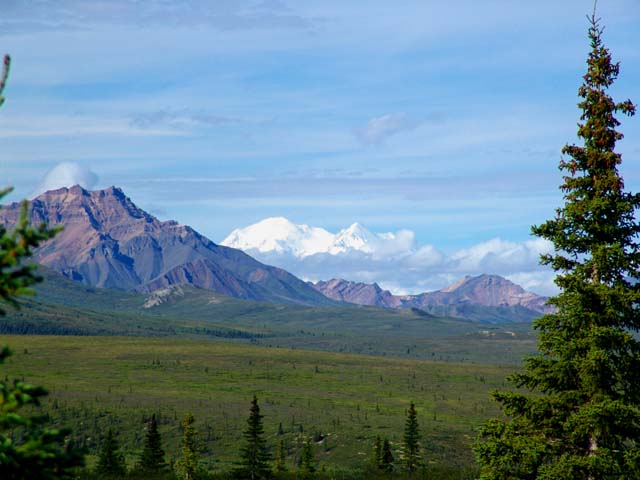
Denali
July 16-21, 2004
We arrived at Denali a few days early so we camped outside the park
until our reservation started at a backcountry campground in the park. Denali
National Park is huge - 6 million acres. There is only one road into
the interior of the park; it ends at Kantishna, about 90 miles away. Except for
the first 15 miles, the road is gravel and closed to private vehicles unless you have
a reservation at a campground - in which case you can only use your vehicle to
drive to the campground at the beginning of your stay and drive out at
the end. To get further into the park you ride on their shuttle buses.

Mt. McKinley, aka Denali (the Indian name), is seldom visible;
it is the snow-covered mountain in the background above the clouds.
This is the best view we had, which is from mile 9 on the park road; at this point
Denali is about 70 miles away as the crow flies. The south peak (the rounded
peak on the left),
at 20,320 feet, is the highest mountain in North America. The triangular
shaped peak on the right is the north peak, and is about 900 feet lower than the
south peak.

One of the park shuttle buses at the Polychrome Overlook rest
area. We rode the buses deep into the park on two different days - once to
Eielson Visitor Center (at mile 66) and once to Wonder Lake (at mile 85). It
takes most of the day for either trip, even from our campground which was at
mile 29. The bus rides take so long because the drivers stop when wildlife is
spotted - grizzly bears, Dall sheep, caribou, moose, wolves, etc. Since "the
mountain" (meaning Denali) is seldom visible, the wildlife is the primary
attraction of the park. A free tip concerning the bus rides - skip Wonder Lake
and only go as far as Eielson. There is less wildlife after Eielson, and the
scenery is not as interesting.

With tree line at about 2700 feet, the park is mostly tundra. It
appears rather green, although the area is actually classified as semi-arid due to
the low rainfall and the rather dry snow they get in winter.

The rivers in the park originate primarily in glaciers, so they
are full of glacial silt. The water is a brown-gray color and very murky,
so they look seriously polluted if you don't know about the glaciers. The river
channels are very broad and mostly gravel, with the stream running in channels
that interconnect like braids, so they are called "braided rivers".
Since the animals are a highlight of the park, we have put our photos of the wildlife on the next web page.
Visibility of Denali:
First you have to realize that Denali is more often hidden in clouds than not.
According to the rangers, most visitors never see the mountain. Denali is only
completely visible on about 10 percent of the days during the summer, and then
only for a short period each day. On about 50 percent of the days you can't see
the mountain at all. On the remaining days it will appear, again briefly, but
partially obscured by clouds. The mountain is more likely to be visible in the
morning, since clouds build up during the day. As one bus driver said, "the
mountain is a magnet for clouds; if there is a cloud in the sky, it will most
likely be hanging on Denali."
Tips for Seeing the Mountain (accumulated after only a
few days of experience, so take it for what it is worth):
1. Camp at Wonder Lake (tents only), which is 27 miles away from Denali; it is as close as you can
get without backpacking. Then get up early in the morning to see if "the
mountain is out".
2. Take an early bus (before 6 AM) from the east entrance of the park. It will
get you to the Eielson Visitor Center, which is 33 miles from the mountain, before 10
AM - getting there after that is probably too late.
3. Skip the national park and camp at the Denali View North campground in Denali
State Park. This is about 40 miles southeast of the mountain. The campground is
basically a parking lot, but you will be able to see the mountain from your RV
if it is "out". Again - get up early in the morning to take a look.
4. Give up and buy a professional photo of the mountain; then you can look it
anytime you want. We opted for this option.